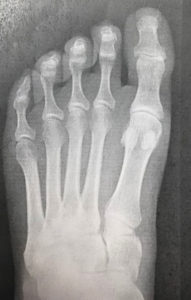19 Apr Lisfranc Injury



Lisfranc injury is also known as Lisfranc fracture, Lisfranc dislocation, Lisfranc fracture dislocation, midfoot injury and foot sprain. This injury can be challenging to diagnose and is often missed diagnosis by the nonspecialist.
Causes of Lisfranc fracture dislocation include stepping ina hole where the foot is rotated downward, falling from a horse with the foot remaining in the stirrup and direct crush injury to the foot. Patients will pain throughout the midfoot with circumferential swelling, pain throughout the midfoot with attempts at walking, bruising and possible blistering and abnormal widening of the foot.
Your podiatrist with perform a history and physical along with an exam of the injured foot. The doctor should always perform x-rays and it is very helpful to perform x-rays of the uninjured foot for comparative purposes to determine if there is widening (instability) at Lisfranc’s joint. Your foot and ankle specialist may also order additional studies such as an MRI of CT scan.
Treatment may or may not involve surgery. If there is no fracture or dislocation in the joint and the ligaments are not torn, nonsurgical treatment is indicated in the form of casting and nonweightbearing for six weeks. Strict nonweightbearing with fracture boot/cast and crutches must be adhered to and this is followed by a gradual return to weightbearing using a brace prior to returning to full activities.
Surgery is indicated for Lisfranc fracture dislocation when a fracture in the joints of the midfoot are present or there is abnormal positioning (subluxation) of the joints. The goal of surgical correction is to realign the joints and return the fractured bones to a normal anatomical position. The surgery requires reducing the deformity in the operating room under x-ray and then placing screws (pictured here) or plates to maintain the corrected position. It is possible that some or all of the hardware may have to be removed at some point in the future. After surgery patients will be required to remain nonweightbearing in a fracture boot/cast for a period of six to eight weeks. This is followed by a gradual return to weightbearing using a brace and possible physical therapy.
It is important to note that some athletes never return to their pre-injury level of sporting activity after Lisfranc fracture dislocation. Despite accurate and excellent surgical reduction with fixation it is possible for arthritis to develop in the injured joints resulting in chronic pain. This chronic pain to the joints may require further surgery in the form of fusion (arthrodesis) in the future.



